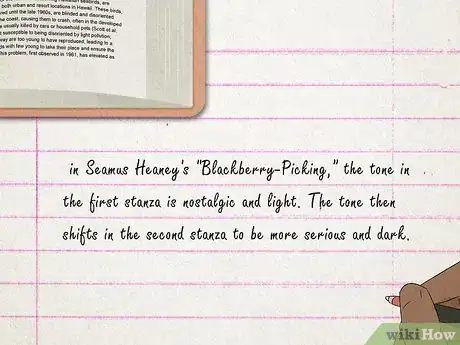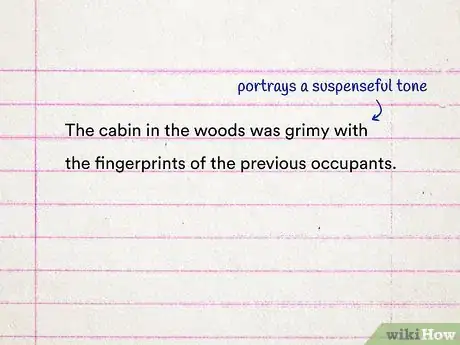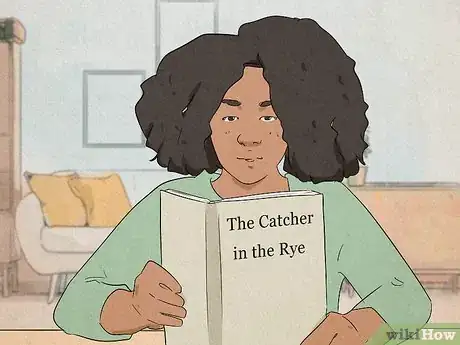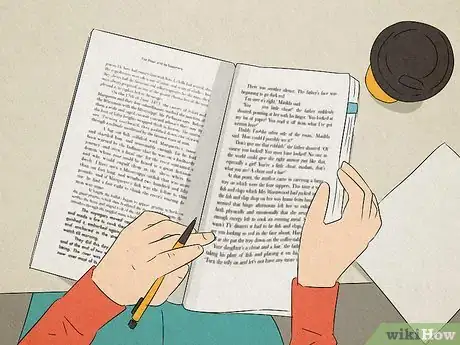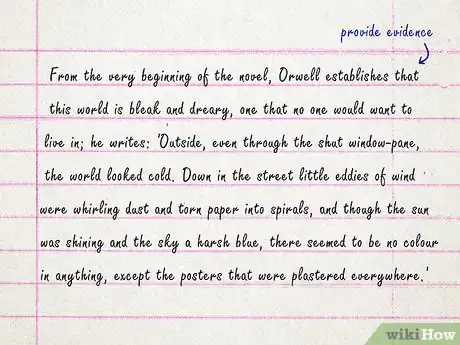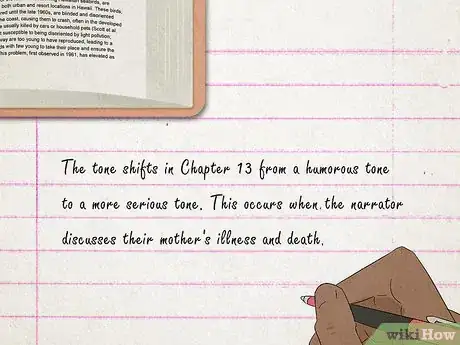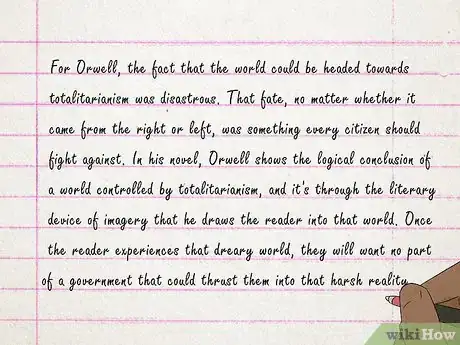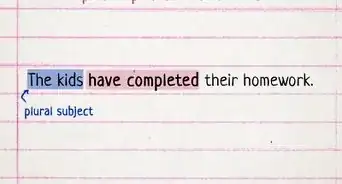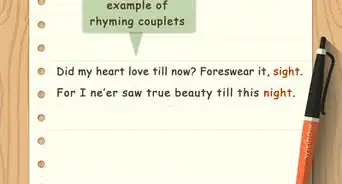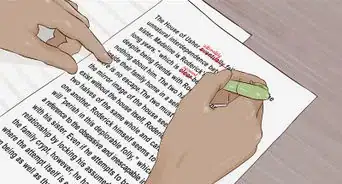This article was co-authored by Tristen Bonacci. Tristen Bonacci is a Licensed English Teacher with more than 20 years of experience. Tristen has taught in both the United States and overseas. She specializes in teaching in a secondary education environment and sharing wisdom with others, no matter the environment. Tristen holds a BA in English Literature from The University of Colorado and an MEd from The University of Phoenix.
There are 10 references cited in this article, which can be found at the bottom of the page.
wikiHow marks an article as reader-approved once it receives enough positive feedback. This article received 11 testimonials and 100% of readers who voted found it helpful, earning it our reader-approved status.
This article has been viewed 463,006 times.
In literature, tone refers to the author's attitude toward the subject, characters or events of a story.[1] Understanding the tone of a literary work can help you become a better reader. You may also need to analyze the tone of a literary work for an essay or assignment for class. To analyze tone, start by recognizing common tones in literature. Then, determine the tone in a literary work and describe it effectively so you get high marks on your essay.
Steps
Recognizing Common Tones in Literature
-
1Notice if the tone is solemn or gloomy. One of the most common tones in literature is a solemn or gloomy tone, where the tone feels heavy or serious. Often the tone comes across as bleak or dark if it is solemn. You may respond to a solemn literary work by feeling sad or unsettled.[2]
- A good example of a solemn or gloomy tone is in the short story “The School” by Donald Barthelme.
-
2Recognize a suspenseful tone. Another common tone in literature is a suspenseful tone, which creates a sense of dread and anticipation in the reader. Often, you may feel on the edge of your seat or full of anxiety as you read a literary work with a suspenseful tone.[3]
- A good example of a suspenseful tone is in the short story “The Lottery” by Shirley Jackson.[4]
Advertisement -
3Take note of a humorous tone. A work of literature with a humorous tone will often make the reader laugh or smile. It can come across as playful, witty, or ironic. Sometimes writers use a humorous tone to counter a solemn tone in the same work, such as in a novel or a short story.[5]
- A good example of a humorous tone is the poem “Snowball” by Shel Silverstein.
-
4Notice a sarcastic tone. A sarcastic tone is often used to invoke laughter or amusement in the reader. It may come across as biting and critical. You can find a sarcastic tone in novels and short stories, particularly if they are told in the first person with a narrator who has a sarcastic or dry sense of humor.[6]
- A good example of a sarcastic tone is in the novel The Catcher in the Rye by J.D. Salinger.
-
5Recognize the connection between tone and genre. In many cases, the genre of the piece can give you clues about the tone. For instance, a suspenseful tone is often found in thriller novels or mystery stories while a humorous tone is often found in works of comedy and satire.
-
6Be aware of the difference between mood and tone in literature. It can be tricky to distinguish between mood and tone in literature, especially because they are often connected or interrelated. Mood is different from tone in that it describes the setting and atmosphere of a text. Mood is created through the reader's response to the tone in a work. However, both mood and tone are shaped by the writer's ability to convey emotion in the reader.[7]
- For example, if a story is set in an abandoned cabin the woods, it may have a creepy or unsettling mood. The author may then have a narrator or main character who uses a gloomy or depressing tone to describe the cabin in the woods to the reader.
Determining the Tone in a Literary Work
-
1Notice the word choice and language. One way you can determine tone in a literary work is to pay attention to the words and language used by the author.[8] Consider why the author chose certain words or language to describe a scene. Think about why certain words were used to discuss a character. Think about how these choices create tone.[9]
- For example, you may study a passage from the short story “The School:" “And the trees all died...I don't know why they died, they just died. Something wrong with the soil possibly or maybe the stuff we got from the nursery wasn't the best...All these kids looking at these little brown sticks, it was depressing.”
- In the passage, Barthelme creates a solemn, gloomy tone by using words like “depressing,” “dead,” “died,” and “wrong.”
- Lady Macbeth uses the word damn in the play Macbeth.[10]
- It depicts the tone of anger and shows her pride.[11]
-
2Look at the sentence structure. Read a few lines of the literary work and notice how the sentences are structured. You may notice the sentences are short and often do not vary in length, creating a certain tone. Or you may notice sentences that are long and winding down the page. This could create a meditative or thoughtful tone.[12]
- For example, in many thriller novels, the sentences are often short and to the point, with very few adjectives or adverbs. This can help to create a suspenseful tone, full of action and tension.
-
3Examine the imagery. Another way you can determine the tone of a piece is to look at the imagery used by the author to describe a setting, scene, or character. Certain imagery will create a certain tone to the piece. Strong imagery can tip you off to the tone intended by the author.[13]
- For example, if a person's face is described as “glowing with happiness and excitement,” this may create a joyful tone. Or if a cabin in the woods is described as “grimy with the fingerprints of the previous occupants,” this may create a suspenseful tone.
-
4Determine if the author uses irony. There are different kinds of irony, including verbal, situational, and dramatic. A situation is described as ironic if the expectations and reality of that situation are incongruous. Irony is often tied to sarcasm, but not always. Take note of the use of irony in literature and examine how it contributes to the tone or to a tonal shift.[14]
- For example, if someone says, “Good thing I wore my parka today” when the temperature is 85 °F (29 °C), they're using verbal irony.
-
5Read the work out loud. Reading a work of literature out loud can help you get a better sense of the diction of the piece. Diction refers to how words sound next to one another in a sentence. It is often more clear when a work is read out loud, as you can hear how each word sounds and pay attention to how this creates a certain tone to the piece.[15]
- For example, you may read the following lines from The Catcher in the Rye out loud to determine the tone: “God damn money. It always ends up making you blue as hell.” The use of “god damn” and “blue as hell” gives the line a sarcastic or bitter tone, with a hint of humor and sadness.
-
6Note that a work can have more than one tone. It is common for an author to use more than one tone in a work of literature, especially a long work like a novel. You may notice that the tone shifts in the work from chapter to chapter, narrator to narrator, or scene to scene. The author may do this to get into the particular voice of a character or to signal a shift in the characters or the action in the piece.[16]
- For example, a novel may begin with a humorous tone and shift into a more serious tone as the author delves deeper into a character's history or personal relationships.
Describing the Tone in a Literary Work
-
1Use adjectives. To describe the tone of the literary work, use specific adjectives that illustrate which tone the narrator is using, such as “gloomy,” “solemn,” “humorous,” or “sarcastic.” The more specific you are when describing the tone, the more insightful your analysis will be.[17]
- For example, you may write, “The author uses words like “super,” “stoked,” “awesome,” and “exhilarating” to create an upbeat tone.”
- You can use more than one adjective if this will make your description more accurate.
-
2Provide evidence from the text. After describing the tone in detail, use a few quotes from the text to back up your argument. Pick quotes that clearly illustrate tone based on word choice, language, diction, or imagery.
- For example, if you are writing about The Great Gatsby by F. Scott Fitzgerald, you may use the last line of the book as an example: “So we beat on, boats against the current, borne back ceaselessly into the past.”
- You can then note that the imagery of a boat going against the current as well as the use of the words “beat,” “borne,” and “past” create a solemn, nostalgic tone to the ending.
-
3Compare different tones in the same work. If there is more than one tone in the work, compare the different tones in your analysis. This often occurs when the literary work is long, such as a novel or an epic poem. Identify when the shifts in tone occur in the literary work. Discuss why you think the tone shifts and how it affected you as a reader.
- Note if the tonal shifts coincide with specific characters and/or changes in perspective or viewpoint.
- For example, you may note, “The tone shifts in Chapter 13 from a humorous tone to a more serious tone. This occurs when the narrator discusses their mother's illness and death.”
-
4Link the tone to other literary elements. Depending on the scope of the assignment, make sure your analysis of tone is connected to other elements such as mood, plot, theme, and style. The tone of a work is often used to illustrate a larger theme or to create a distinct mood. Linking tone to these other elements can sharpen your analysis and make it that much stronger.
- For example, you may link the nostalgic, solemn tone of the closing line in The Great Gatsby to the themes of remembrance, loss, and thwarted love in the novel.
Expert Q&A
-
QuestionHow do you better understand the tone of a story?
 Tristen BonacciTristen Bonacci is a Licensed English Teacher with more than 20 years of experience. Tristen has taught in both the United States and overseas. She specializes in teaching in a secondary education environment and sharing wisdom with others, no matter the environment. Tristen holds a BA in English Literature from The University of Colorado and an MEd from The University of Phoenix.
Tristen BonacciTristen Bonacci is a Licensed English Teacher with more than 20 years of experience. Tristen has taught in both the United States and overseas. She specializes in teaching in a secondary education environment and sharing wisdom with others, no matter the environment. Tristen holds a BA in English Literature from The University of Colorado and an MEd from The University of Phoenix.
Licensed English Teacher Try rewriting a certain sentence or passage in a different way. Take Lady Macbeth's classic guilt scene, for instance—you could try rewriting it from the perspective of a 16-year-old gang member, or a 10-year-old who pushed his brother off the bike. How would this feeling look for these different people, and does the tone stay the same when you rewrite these things?
Try rewriting a certain sentence or passage in a different way. Take Lady Macbeth's classic guilt scene, for instance—you could try rewriting it from the perspective of a 16-year-old gang member, or a 10-year-old who pushed his brother off the bike. How would this feeling look for these different people, and does the tone stay the same when you rewrite these things? -
QuestionHow do I prove the tone at length once I've identified it?
 Community AnswerGive examples from the text and, if possible, explain how it can impact the readers.
Community AnswerGive examples from the text and, if possible, explain how it can impact the readers. -
QuestionWhat does the "author's usage of words" refer to?
 Community AnswerThe length of the words, the amount of description, whether or not they drop words, the informality or formality of their words, whether or not they use slang or dialect. Also the kinds of words they use - whether they describe things using neutral words, or positive, negative, angry words, etc., and anything else you notice that you feel contributes to the tone.
Community AnswerThe length of the words, the amount of description, whether or not they drop words, the informality or formality of their words, whether or not they use slang or dialect. Also the kinds of words they use - whether they describe things using neutral words, or positive, negative, angry words, etc., and anything else you notice that you feel contributes to the tone.
References
- ↑ https://liberalarts.oregonstate.edu/wlf/what-tone-literature-definition-and-examples
- ↑ https://literarydevices.net/tone/
- ↑ http://www.inetteacher.com/upload1/102670/docs/Tone-Mood%20Worksheet.pdf
- ↑ https://www.cusd200.org/cms/lib/IL01001538/Centricity/Domain/361/jackson_lottery.pdf
- ↑ https://literarydevices.net/tone/
- ↑ https://literarydevices.net/tone/
- ↑ http://study.com/academy/lesson/tone-vs-mood-interpreting-meaning-in-prose.html
- ↑ Tristen Bonacci. Licensed English Teacher. Expert Interview. 21 December 2021.
- ↑ https://literarydevices.net/tone/
- ↑ Tristen Bonacci. Licensed English Teacher. Expert Interview. 21 December 2021.
- ↑ Tristen Bonacci. Licensed English Teacher. Expert Interview. 21 December 2021.
- ↑ http://literarydevices.net/syntax/
- ↑ http://www.inetteacher.com/upload1/102670/docs/Tone-Mood%20Worksheet.pdf
- ↑ http://www.literarydevices.com/irony/
- ↑ http://www.inetteacher.com/upload1/102670/docs/Tone-Mood%20Worksheet.pdf
- ↑ https://www.wheaton.edu/academics/services/writing-center/writing-resources/style-diction-tone-and-voice/
- ↑ https://www.apstudynotes.org/english/sample-essays/style-analysis-tone-of-voice-words/
About This Article
The tone of a piece of literature refers to the author’s attitude toward the characters, events, and subject matter of the story. The tone of a text can vary from solemn to suspenseful to humorous and lighthearted. To figure out the tone of a passage or text, look at the word choices and images the author uses. For instance, if there are lots of words associated with darkness and death, the tone’s probably quite gloomy. However, a writer can also make the piece humorous by using irony and subverting your expectations. Remember to link the tone to other elements like the plot, style, and major themes of the text to help you analyze it. For example, in The Great Gatsby, you could link the nostalgic, solemn tone of the closing line to the themes of loss, and thwarted love. For more tips from our Education co-author, including how to use sentence structure to analyze tone, read on!








